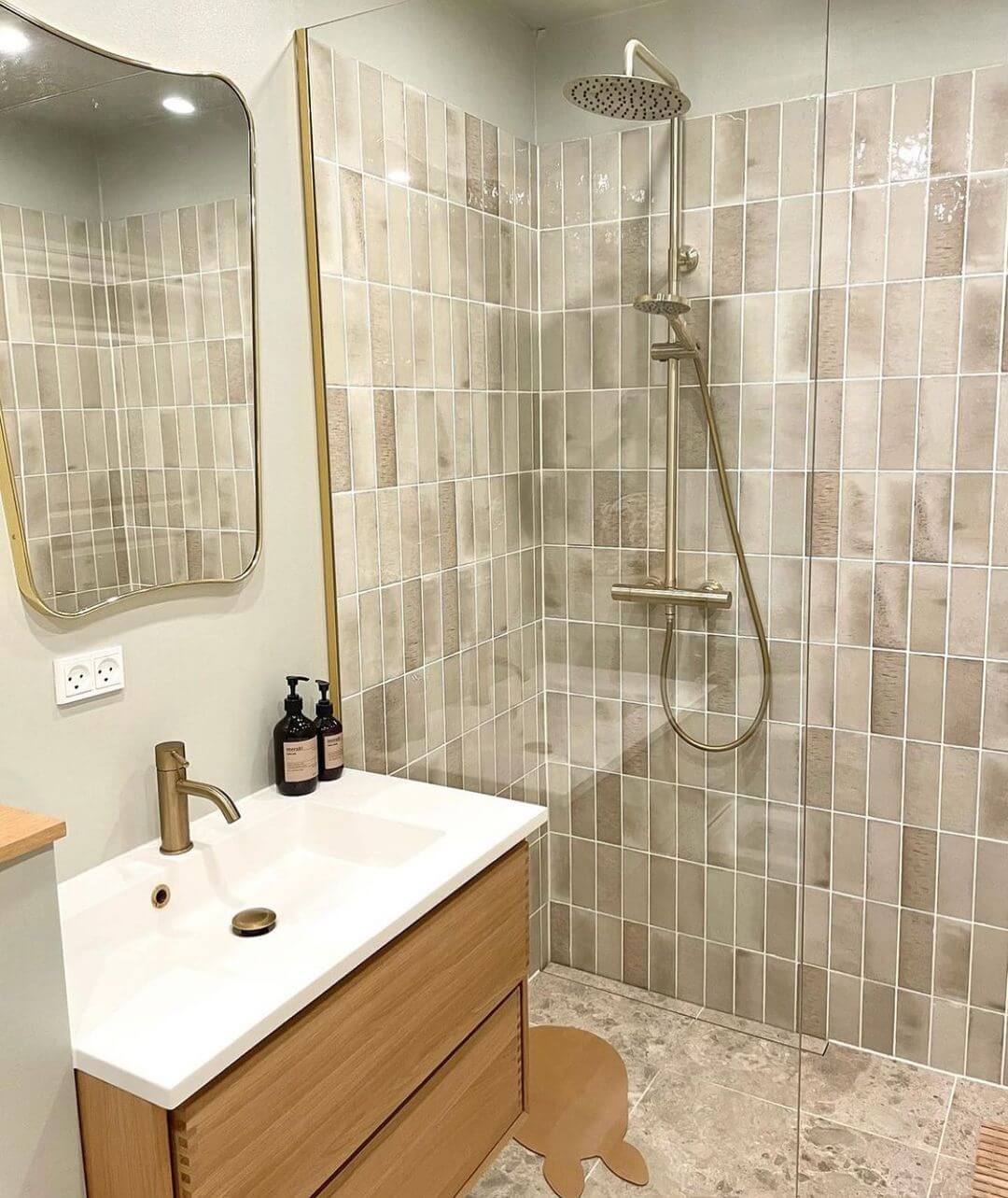Cleaning the floor tiles and wall tiles in the bathroom is an important part of the cleaning if you want to ensure that they stay nice for as long as possible.
It is easy and takes a relatively short time to clean the tiles in the bathroom, and if you make it part of the weekly cleaning, it can help to extend the life of the tiles. We give you our best tips and tricks on how best to clean your tiles and clinker, so you can enjoy the sight of a sparkling clean bathroom.
Choose the right cleaning agents
Take into account which tiles you have in the bathroom and which type of cleaning agent they can withstand. There is a big difference between the type of tiles and the surfaces the different types of tiles have. As a starting point, you can often just clean the tiles in the bathroom with warm water and a mild detergent that is gentle on tiles and clinker.
Tiles with glazed surfaces can often withstand a little more, and can advantageously be washed down with a regular cleaning agent and warm water. They usually also tolerate most descaling agents, so here you can try your hand quietly. If you have natural or marble clinker, you must often be careful not to use too harsh cleaning agents with too much acid.
A good tip is to start with a small area and then see how the tiles or clinkers react to it. Once you have used the wrong cleaning agent, it is difficult to do anything if your tiles react badly to, for example, acid. So start quietly and try your way. In this way, you avoid damaging your tiles and clinker in the bathroom.
Can I use vinegar on my tiles or tiles?
You can use vinegar on your tiles or clinker, but it is important that you try it out before doing the whole cleaning process, so that you are sure that they can withstand it.
It is important that you do not use vinegar or citric acid to clean the joints in your tiles or bathroom tiles while they are dry. It can risk damaging the tiles and depositing in the joints, as they will absorb the acid.
Marble and terrazzo
If you have tiles or clinker in either marble or terrazzo in the bathroom, it is very important that you do not use acidic cleaning agents, as these materials cannot withstand acid.
Both are natural stone materials that are composed of mineral components and formed through geological processes over time. Acid, on the other hand, is a chemical compound that can be very aggressive towards certain types of stone, such as marble and terrazzo.
If you use acid on the two types of stone, it can in the worst case lead to etching and discoloration of the stone’s surface. This can make the surface of the stone look dull and damaged. Instead, you should use mild cleaning agents designed for stone materials .
If you want to clean your tiles or clinker in either marble or terrazzo, you can advantageously use liquid brown soap or soap shavings instead, as it is gentler on these materials, which can be more delicate. Marble surfaces also benefit from a damp microfiber cloth and warm water, which is effective and gentle.
By following these tips, you can make your marble or terrazzo flooring shine beautifully again.
Also read our tips on how to clean terrazzo easily and simply or see our wide range of beautiful terrazzo tiles .
Always listen to the manufacturer’s recommendations
Some tiles and clinkers can withstand more than others, and it is always a matter of judgement, which cleaning agents to use, depending on which bathroom tiles you have in the home.
It is always a good idea to check with the manufacturer or dealer who sold you the tiles or clinkers to be sure what type of tiles you are dealing with and what they can withstand.
See also: Our selection of beautiful lava stone tiles and Moroccan tiles .


How to clean the bathroom tiles
When you have decided which type of tile you need to clean and which type of cleaning agent your tiles or clinker can withstand, it is time to give it gas with knuckle grease and the right products.
Follow these steps when cleaning the bathroom:
- Start by vacuuming or sweeping the area to remove the worst dust and dirt that may be on the tiles or tiles.
- Make a mixture of warm water and a mild detergent, for example from Stonetreatment, or another cleaning agent specially designed for bathrooms. As I said, avoid using overly harsh, acidic or chlorine-containing cleaning agents, as they can damage your tiles and clinker over time.
- Wash or shower your tile or clinker wall thoroughly with water so that the tiles or clinker are completely soaked. Make sure the water runs down the drain, and shower the entire bathroom thoroughly if it is the shower niche that you need to clean.
- Apply the cleaning agent with a cloth or sponge. Make sure it covers the entire area where there are tiles or clinker. Let it sit for a few minutes to dissolve stains and dirt (no longer, as it can damage tiles and clinker).
- Scrub the area thoroughly with a soft brush or a gentle sponge to dissolve all dirt and stains on the tiles. When scrubbing the tiles or clinkers, remember to be careful so you don’t scratch them.
- Finally, rinse the entire area thoroughly with clean water to remove all detergent from the tiles or clinkers. It is important to ensure that all cleaning agents are washed off, so that no soap residue settles on the tiles.
- Wipe down tiles or tiles with a clean cloth or tea towel to prevent water spots and streaks.
- If there are still stubborn stains or limescale on your bathroom tiles, you can try repeating the process with a slightly stronger detergent that can dissolve dirt and limescale deposits. Alternatively, you can try making a solution with water and baking soda that can act as a mild abrasive. Try your hand at a small test area.
You must be aware of that
In addition to the use of acid, you must also pay particular attention to properly protecting your hands and avoiding contact with the eyes when you start cleaning the bathroom. It is always good to use rubber or neoprene gloves when working with harsh cleaning agents that can damage the skin and eyes.
When rinsing the soap residue off the tiles, it’s also a good idea to avoid too much water, as this can cause water penetration. Although tiles and joints are normally waterproof, an excessive amount of water can still damage the substrate. Therefore, you must always remember to wipe off all excess water with a dry cloth or towel after cleaning.
If you want to prevent mold in your bathroom, make sure to always dry the tiles thoroughly and ventilate the room well after you have showered. In this way, you avoid unwanted mold growth in the bathroom.
See also: Our entire selection of bathroom tiles .


